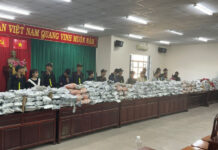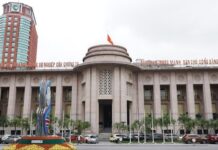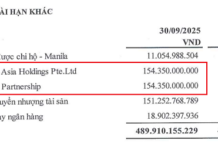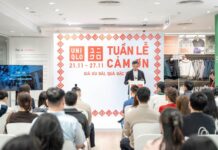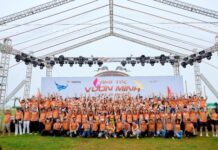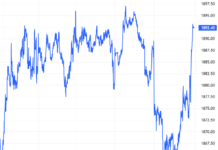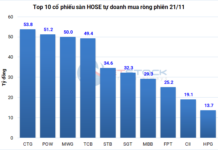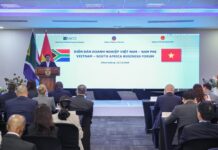
A production line of electronic circuit boards at Nexcon Vietnam Co., Ltd., a South Korean-invested enterprise in Bac Ninh province. Photo: Danh Lam/VNA
According to the Foreign Investment Agency under the Ministry of Planning and Investment, as of the end of July 2024, the total registered FDI capital in Vietnam reached over $18 billion, up 10.9% compared to the same period in 2023. Thus, in the first seven months of 2024, both registered and realized FDI capital continued to increase compared to the same period, with growth rates of 10.9% and 8.4%, respectively.
Notably, disbursed capital reached over $12.55 billion, up 8.4% over the same period last year. This is the highest FDI disbursement in the first seven months over the past five years (2020 – 2024).
Many international organizations forecast that with this momentum, FDI disbursement in the coming time is expected to be higher. At the same time, Vietnam’s business environment is also highly appreciated by the FDI business community. The infrastructure with many large projects and the driving force for spillover effects is being invested to complete, which is a condition to welcome FDI in the future. Especially, foreign investors are very interested in the semiconductor industry in Vietnam.
Dong Nai is one of the localities that continue to attract strong FDI inflows. The Management Board of Dong Nai Industrial Zones (DIZA) said that the total FDI attraction in the first seven months of 2024 reached $1.019 billion (reaching 146% of the annual plan). New licensed FDI projects mainly belong to the industries of semiconductor production, electrical and electronic components; mechanical manufacturing; textile; and production of products from cast metal…
“There are no projects belonging to the list of industries with polluting factors, labor-intensive; ensuring advanced technology criteria; in line with Dong Nai province’s investment attraction policy,” said a representative of DIZA.
With positive FDI inflows into localities, Deputy Minister of Planning and Investment Tran Quoc Phuong said that according to a survey by the Ministry of Planning and Investment, the confidence of FDI investors remains very positive, reflecting their desire to continue investing in Vietnam.
Regarding FDI attraction in the last months of 2024, Deputy Minister Tran Quoc Phuong said that many international financial organizations have positive assessments and are optimistic about Vietnam’s FDI attraction thanks to three factors: diversification of supply investment strategies; Vietnam’s economic growth prospects have many bright spots, positively affecting the investment strategy of investors; and fundamental factors.
“According to a survey by the Ministry of Planning and Investment, the confidence of FDI investors remains very positive, reflecting their desire to continue investing in our country. Therefore, it is possible to expect that FDI attraction in the whole year of 2024 may reach $39-40 billion, higher than the same period in 2023,” said Deputy Minister Tran Quoc Phuong.
From the perspective of a state management agency, Mr. Do Nhat Hoang, Director of the Foreign Investment Agency, said that there is a new wave of investment in Vietnam. This fourth wave is formed from the increasing investment demand of partners such as Korea, Japan, China, and the US. Specifically, in Korea’s southward policy, Vietnam is number one, and Korean investors make decisions very quickly. Samsung alone has expanded its investment to a scale of $22 billion for projects in Vietnam.
According to Mr. Vo Van Minh, Chairman of the People’s Committee of Binh Duong province, domestic investment capital and total social investment capital of tens of thousands of billions of VND annually have created a great driving force for the province’s development.
In the context of such competition, to attract high-quality FDI, the Chairman of Binh Duong province proposed that Vietnam must have high preferential policies and support besides corporate income tax for high-tech projects, source technology projects, especially the semiconductor manufacturing industry. Along with that, administrative procedure reform also needs to be implemented more drastically and thoroughly to avoid harassment that reduces investors’ trust.
At the same time, Vietnam also needs to quickly develop a synchronous infrastructure system, especially transport infrastructure connecting airports, seaports, and big cities with industrial centers. In addition, the energy infrastructure also needs to be upgraded and invested, especially in developing renewable energy projects that meet the standards and requirements of high-tech production, environmental protection, and CO2 emission reduction.
Emphasizing the key solution to promote FDI attraction, the Minister of Planning and Investment said that the Ministry would urgently review and drastically remove difficulties and obstacles in institutions, laws, and administrative procedures to create a breakthrough driving force.
At the same time, focus on attracting large-scale, high-quality FDI projects with advanced technology in the processing and manufacturing industries, electronics, and semiconductors; and promptly handle difficulties and obstacles of FDI enterprises to speed up the progress of projects.
Regarding the development of the semiconductor industry in Vietnam, recently, the National Innovation Center (NIC) in collaboration with Cadence Group, FPT Group, and Tresemi Organization (USA) organized a seminar on “Promoting the role of Vietnamese enterprises in developing human resources for the semiconductor industry.”
Mr. Nguyen Chi Dung, Minister of Planning and Investment, affirmed that the cooperation of NIC with domestic and international partners to build training programs in circuit design is an important step in the journey of Vietnamese people gradually mastering technology in the semiconductor industry. This is an important solution to promote the breakthrough of the human factor value of Vietnam in the Strategy for Socio-Economic Development for the period of 2021 – 2030.
According to Mr. Truong Gia Binh, Chairman of the Board of Directors of FPT Group, never in such a short time have universities participated in training in the semiconductor industry so quickly and readily. Considering the key factor to enhance cooperation between the government, schools, and businesses in developing human resources for the semiconductor industry to be the close and effective coordination between the three parties, Mr. Truong Gia Binh said that there should be clear mechanisms to share information, resources, and experience among related parties.
“The cooperation between the Government – Institutes, Schools – Enterprises is the driving force for unprecedented development and innovation in Vietnam’s technology field. This cooperation will also be much boosted when the Project on Developing Human Resources for the Semiconductor Industry by 2030, with a vision to 2050, has been submitted by the Ministry of Planning and Investment and will soon be approved by the Government,” Minister Nguyen Chi Dung emphasized.
Why did Amkor choose Vietnam as the world’s largest semiconductor production hub?
Bắc Ninh province boasts excellent infrastructure, meeting “special” requirements and cutting administrative procedures by one-third. Its infrastructure ranks among the best in Southeast Asia, which is one of the reasons why Amkor Corporation has chosen this province as the largest semiconductor production hub in the world.
Vietnam’s Advantages in the Multi-Billion Dollar Semiconductor Industry
With a young and abundant workforce, a deep understanding of technology, and a rapidly developing infrastructure, Vietnam has a competitive advantage in the semiconductor industry, particularly in the design phase. According to a survey by the Ministry of Planning and Investment, by 2030, Vietnam will have the capacity to train around 50,000 engineers in this field.




